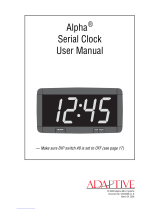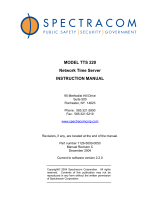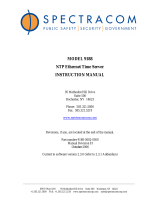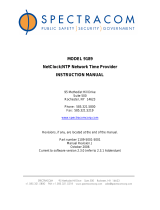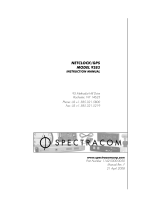Page is loading ...

Krontek KT160 Rev 4.10
2
SETUP OVERVIEW
All settings are via three pushbutton keys on the rear of the clock:
The SYSTEM key, the TIME key and the ADJUST key. We will refer to these keys from now on
as SYS, TIME and ADJ.
Th
e keys operate as follows:
SYS enters System mode and sets the system options including the date.
(
Important
-
the SYS key is required to be held down for at least 4 seconds to activate)
TIME enters Time mode and sets the time.
ADJ is used to make c
hanges when either SYS or TIME mode is selected. The ADJ key is also
used to select the display intensity when not in TIME or SYS mode.
Please note that if the Network Option is fitted most settings can be adjusted via the network. See
Network Interface Option at the end of this manual.
When the clock first powers up it will briefly display its software revision number in the following
format X-YY where X is the primary revision number and YY is the secondary. A C is
appended for the calendar versio
n.
Holding down any key during power up will reset the clock configuration to its default state.
The default state is:
Time: 00:00:00
24 hour display
Seconds on
Correction format: NONE
Time Zone Offset: 00:00
Daylight Savings: 0 (Off)
Date: 1
-
Jan
-
2005
Action display: Alert
The ADJ will auto
-
repeat if you hold the key down for more than 3 seconds and the repeat speed
will increase after 8 seconds.
When in System mode pressing the TIME key will exit the System mode.
When in Time mode pressing
the SYS key will exit the Time mode.
When more than one adjustable field is displayed the active field (the field you can change) will
flash.
When referring to a displayed clock field in this manual the field is bracketed i.e. [SEC on].

Krontek KT160 Rev 4.10
3
SETTING THE
CLOCK
1 Setting the time
If you are setting the time during Daylight Savings (DLS) do not add the extra hour i.e. if DLS time
is 8:30pm you must enter the time as 7:30pm (Standard Time). When you set the DLS period
(see 6
-
Setting Daylight Savings)
the clock will automatically adjust for DLS and add the extra
hour.
Press TIME, the clock will display the time that the key was pressed and the hours will flash. The
format is HHMMSS.
To change the hours use ADJ.
Press TIME again to advance to the min
utes.
To change the minutes use ADJ.
Press TIME again to advance to the seconds.
Set the seconds about 10 seconds ahead of actual time then wait until actual time is the same
before pressing TIME to set the time.
Pressing SYS will exit time setting wi
thout saving any changes made.
2 Selecting 12/24 hour format
Press and hold SYS, the clock will display [12Hr] or [24Hr] depending on the setting.
Press ADJ to alternate between the two settings.
Use TIME to exit this mode.
3 Selecting Seconds or
AM/PM
Press SYS twice (2) times, the clock will display [SEC on] or [SEC of] depending on the setting. If
seconds are turned off then the AM/PM indicator will be used.
Press ADJ to alternate between the two settings.
Use TIME to exit this mode.
Note:
If AM/PM is selected the clock will default to the 12 hour format. This will not alter the 12/24
hour programmed setting.

Krontek KT160 Rev 4.10
4
4 Selecting the time reference correction format.
NONE is the default. For more detailed information on these formats and how the
clock interprets
them see the section at the end of the manual Description of Time Correction Formats .
The following formats are available:
[NONE]
Clock uses the 50Hz power supply frequency
[Sbcd]
Standard BCD serial data
[Ebcd]
Extended BCD serial dat
a
[Sr2]
Minute Impulse
59th minute correction
[RP]
Minute Impulse
reverse polarity
[Sync]
Sync wired
[Int]
Internal Crystal (does not use power supply frequency)
[SLA]
Slave when using another KT160 as a master
[ALPH]
Alpha
Adaptive Micro Systems
[nE
T]
Ethernet Network
requires network option
Selecting a format other than NONE or Int will disable time setting via the rear keys.
Press SYS three (3) times, the clock will display one of the above settings.
Press ADJ to select one of the settings.
Use TIME to exit this mode.
5 Setting the Time Zone Offset
Press SYS four (4) times, the clock will display the current offset as HHMM.
Press ADJ and the offset will change in 30 minute increments from [00:00] up to [23:30] and then
from [
23:30] down
to [00:00].
Use TIME to exit this mode.
6 Setting Daylight Savings
Press SYS five (5) times, the clock will display the current offset as DLS nn, where nn is the
current setting.
The daylight saving period can be selected by pressing ADJ.
Selecting
0F disables daylight saving (use this setting for network option).
The preset daylight savings times numbered 1
6 are:
Start
End
Where used
1
-
Last
Sun in Oct at 2:00am
Last Sun in Mar at 3:00am
Australia Eastern
2
-
First
Sun in Oct at 2:
00am
Last Sun in Mar at 3:00am
Australia Tasmania
3
-
Last Sun in Mar at 2:00am
Last Sun in Oct at 3:00am
Europe
4
-
First
Sun in Oct at 2:00am
Third Sun in Mar at 3:00am
New Zealand
5
-
Last
Sun in Mar at 2:00am
Last Sun in Oct at 1:00am
UK
6
-
First Sun
in Apr at 2:00am
Last Sun in Oct at 2:00am
USA

Krontek KT160 Rev 4.10
5
7 Setting the Date
Note: The calendar clock will automatically calculate and display the day of week (Mon
-
Sun) from
the date. The non
-
calendar clock requires the date to be set to enable daylight savings t
o
operate.
Press SYS six (6) times, the date will display as DDMMYY and DD will flash.
To change the day of month use ADJ.
Press SYS to select the month.
To change the month use ADJ.
Press SYS to select the year.
To change the year use ADJ.
Press SY
S to set the year and advance to setting the alert message.
8 Setting the Action Message
Press SYS nine (9) times, the date will display as DDMMYY and DD will flash.
To set the action message you must step through the date setting with the SYS key.
Th
e action message is activated when a 24vdc voltage is applied to the action terminals on the
rear of the clock.
There are three display options for the action display (2 for the non
-
calendar clock) these are:
1.
Alert
2.
Evacuate (calendar clock only)
3.
Timer
Select the desired action message using the ADJ key.
If Alert or Evacuate is selected press TIME to exit to the normal display.
If timer mode is selected you have the option of a count up or count down timer.
If the timer display is set to 00:00:00 the
timer will count up from zero to 23:59:59 then roll over to
zero and continue counting.
To preset the timer for count down mode, press the SYS key and the hours will flash, use the
ADJ key to change the setting then press SYS to proceed to minutes, then
again for seconds.
SYS must be pressed after seconds to keep the selected time.
When action is activated the display will count down to 00:00:00 and remain there until action is
deactivated, the preset time is then reloaded.
Press TIME to exit back
to the normal display.

Krontek KT160 Rev 4.10
6
DESCRIPTION OF TIME CORRECTION FORMATS
This section is included to provide a description of how the clock interprets various time correction
formats. It is worth noting that some were never designed for use with digital clo
cks.
In all cases except [Int] the clock utilizes the power frequency as its time base. The reason for this
is that under most circumstances the power frequency is, on average, extremely accurate. We
include the on average caveat as short-
term power gri
d loading can cause the power frequency
to vary. However most power utility companies will ensure a consistent frequency over a twenty
-
four hour period.
Note: To indicate that correction formats were received and executed the colon(s) will flash briefly
e
ach at each new minute (not applicable to Sync wired). If the correction signal is lost the clock
will continue to run from the time of the last correction.
Internal
[Int]: We will cover this first as this is not a correction format but an alternative to
the
power frequency time base which may not be reliable, such as sites that operate off local power
generators. The internal clock crystal provides an accuracy of ± 1 minute a month. For accuracy
of better than ± 5 seconds a month the clock should be order
ed with the temperature
compensated crystal oscillator (TCXO) option.
Standard BCD
[Sbcd]: This format provides hours, minutes and seconds. It updates once a
second. When using this format daylight savings should not be set as the master clock will
provid
e the adjustment.
Extended BCD [Ebcd]: This format provides hours, minutes, seconds, day, month and year. It
updates once a second. When using this format daylight savings should not be set as the master
clock will provide the adjustment.
Minute Impulse
(corrective)
[Sr2]: This correction format was designed for mechanical analogue
clocks and is interpreted slightly differently by this clock. Minute impulses synchronize the clock
by setting the seconds to zero (if the clock is more than 10 seconds past th
e minute the clock will
advance to the next minute). The clock ignores more than one pulse per minute, however the
transition from a previous negative to positive minute pulse at the transition from the 59
th
minute
to zero minutes will cause the clock to s
et the minutes and seconds to zero (if the clock is more
than 10 minutes past the hour the clock will advance to the next hour). Daylight savings should be
set (if used) as the clock will ignore daylight savings corrections from the master.
Minute Impu
lse (reverse polarity)
[RP]: This format consists of minute impulses alternating in
polarity. Minute impulses synchronize the clock by setting the seconds to zero. The clock ignores
any more than one pulse per minute. Daylight savings should be set (if use
d) as the clock will
ignore daylight savings corrections from the master.
Sync Wired
[Sync]: This format consists of an 8 or 12 second pulse indicating an hourly or twelve
hourly correction.
When using this format daylight savings should not be set as the
master clock
will provide the adjustment.

Krontek KT160 Rev 4.10
7
Slave
[SLA]: This format should be used if you wish to run a KT160 as a slave to another KT160.
Master/Slave operation is achieved by wiring two or more clocks in parallel via the A and B
terminals on the rear
of the clock. If the Slave format is not selected the clock will operate as a
Master by default. It is therefore important that all clocks except one be set as Slaves. Having two
Masters on the same circuit will have unpredictable results.
Alpha
[ALPH]:
This format is compatible with the time string used by used by Adaptive Micro
Systems for their moving message displays.
Syncroline
[SLIN]: This is the Krontek Syncroline format.
Net
[nET]: This format is compatible with SNTP (Simple Network Time Protoc
ol). The clock will
derive it s time from a network time server. The network interface option must be fitted for this
format to function. See instructions that follow

Krontek KT160 Rev 4.10
8
Network Interface Option
The Ethernet Interface is designed to enable a KT160N Clock
to obtain time from a SNTP
compliant network timeserver.
Setting the [net] correction format is not required as the Clock detects it has a network interface
attached. However the [net] setting should be confirmed as part of the commissioning process.
A
fter the Clock has been installed it must be configured to operate on your network.
The Clock comes pre configured with an IP address of 192.168.0.128 and responds to a telnet
session on default port 23. There are three options to enable communications wi
th the Clock:
1.
Your network is already compatible, i.e. 192.168.0.xxx
2.
Configure a PC to a compatible IP address, i.e. 192.168.0.50, and use a network
crossover cable.
3.
Use the Krontek DeviceDetector utility.
In reference to point 3, the DeviceDetector util
ity is supplied on a floppy disc with the clock. It is
also available from our website
www.krontek.com.au.
DeviceDetector sends a UDP broadcast
via port 10991 and displays the response from the clock. Each time the utility is opened it will
send a single b
roadcast. It will display all Krontek time devices on the network
to change a
device s settings click on that device. If you experience difficulties it may be that you are not on
the same network or port 10991 is being blocked. Please note that a UDP bro
adcast will only
operate within the same subnet
it will not pass through gateways. Please contact your supplier
or Krontek if you require assistance.
Once the Clock is accessible on your network, open a telnet session using the IP address you
have assig
ned:
telnet xxx.xxx.xxx.xxx
The following screen (or similar) will appear.
**********************************
* *
* Krontek
*
* KT160N Network Clock *
* Rev 2.40 15
-
Jun
-
2007 *
* *
* MAC 00
:20:4A:98:BA:DB *
* *
**********************************
--
Main Menu
--
1
-
Timer Control Menu
2
-
Clock Options Menu
3
-
System Setup Menu
99
-
End telnet session

Krontek KT160 Rev 4.10
9
Select
The Timer Control Menu
allows for timer operation. Both count up and count down t
imer modes
are supported. Other than PReset the timer functions are self explanatory. PReset has two
modes of operation depending on the count up or down mode. In count up mode, PReset will
reset the display to zero once the timer is stopped. In count down
mode, PReset will load the
programmed preset count into the timer. If the preset time is greater than zero the timer will count
down to zero and halt. If the preset time is zero, the timer will count down from zero i.e. the next
second will be 99:59:59.
The Clock Options Menu
enables the selection of various display options. Of importance is the
ability to disable (or lock) the adjustment keys on the rear of the clock. It is recommend that the
keys be locked if the clock is network enabled.
The Sys
tem Setup Menu
requires more detailed explanation:
--
System Menu
--
1
-
Set Time Server poll period
2
-
Set Daylight Saving
3
-
Set Time Zone Offset
4
-
Set Time Server IP address
5
-
Set Clock IP address
6
-
Reset Poll Error Counts
7
-
Displa
y System Stats
8
-
Set/Change Passcode
9
-
Exit to Main Menu
Select
1.
Set Poll Period allows the selection of the period between SNTP server polls, the
minimum is 1 hour and maximum is 24 hours, one hour is recommended. Any changes
must be saved. Selec
ting this item will also force a poll of the timeserver.
2.
Set Daylight Saving produces a daylight saving table from which an entry can be
selected. Alternatively daylight saving can be disabled or customised to your region. Note
that the clock daylight sav
ing setting should be set to OF
3.
Set Time Zone Offset allows the entry of the number of hours added or subtracted from
UTC (originally GMT). UTC is the time provided by a timeserver.
4.
Set Time Server Address enables you to set the IP address of the SNTP
server on your
network. The screen will prompt you by showing the first octet in brackets (xxx) and allow
you to change it or leave as is. Pressing enter will take you to the next octet, continue
until all four are set. You can also set the subnet mask a
nd gateway in this menu option.
5.
Set Clock IP Address allows you to change the IP address and the Gateway address of
the Clock. The screen will prompt you by showing the first octet in brackets (xxx) and
allow you to change it or leave as is. Pressing enter will take you to the next octet,
continue until all four are set.

Krontek KT160 Rev 4.10
10
6.
Reset Poll Error Counts allows you to reset the count of failed timeserver polls.
7.
Display System Stats displays various system data.
8.
Set/Change Passcode allows you to set the passcod
e to restrict unauthorized access to
the controller. Four characters are required. Alpha (A
-
Z) and numeric (0
-
9) characters are
accepted. Lower case characters are internally converted to upper case. A code of four
zeros (0000) will disable passcode checki
ng.
/

